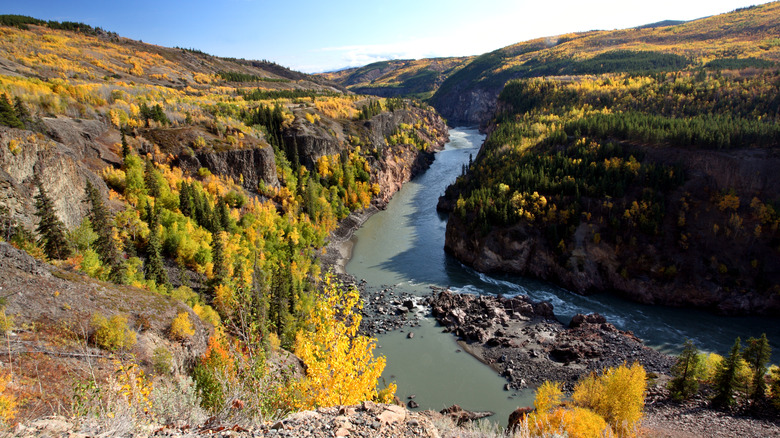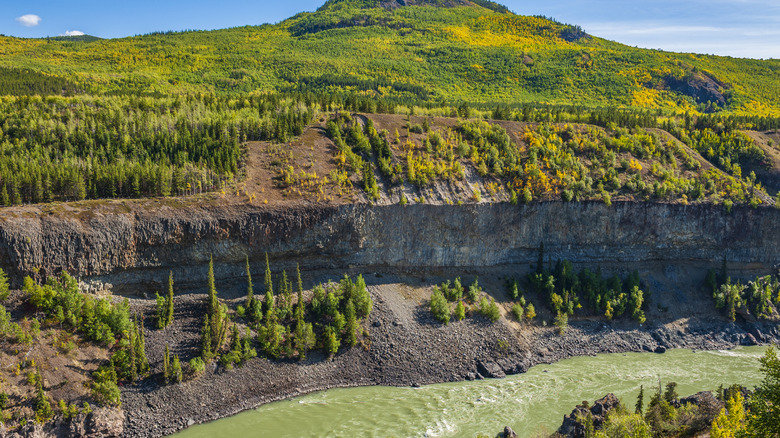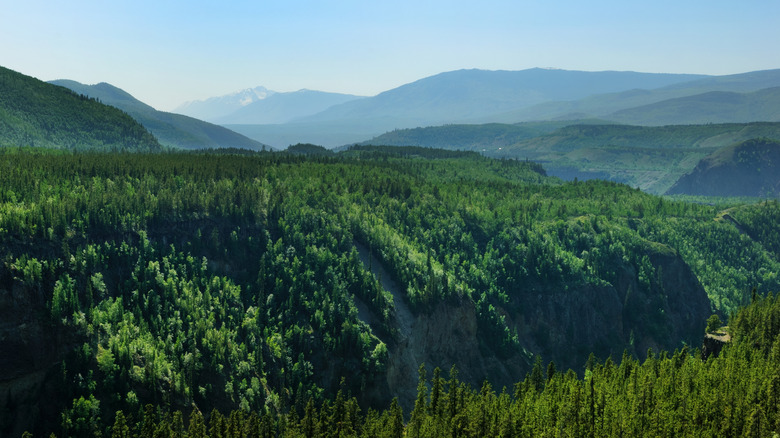The 'Grand Canyon Of The North' Is A Majestic Canadian Chasm With Crystal Clear Waters And Hiking Trails
Snow-shouldered mountains, opal-hued lakes, and sweeps of ancient rainforests all conspire to make British Columbia a veritable promised land for adventurers. From shipwreck scuba diving on Vancouver Island to skiing down the powdery slopes of Whistler-Blackcomb and surfing on Vancouver's wild western coast, this is a place to crank up the adrenaline and get into the great outdoors. It also happens to be the home of the self-proclaimed "Grand Canyon of the north," which you'll find nestled along the course of the Stikine River, deep in the northern reaches of the province.
The Stikine itself flows a whopping 379 miles from high in the British Columbia mountains all the way to the Pacific Ocean. Over the course of millennia, the river has carved out a deep chasm in the rock shelf here, creating a truly dramatic landscape with walls of stone that can reach nearly 1,000 feet in height at certain points. That's enough to claim it the crown as the deepest canyon in Canada, drawing everyone from hiking buffs to daring whitewater enthusiasts with its mix of lookouts and legendary fast-flowing rapids.
Getting here is likely to be a bit of an adventure in itself. The drive up to the park from Vancouver will take in excess of 18.5 hours! Thankfully, you can cut the journey to just under 11 hours by flying into the Prince George Airport. It's Highway 37 virtually the whole way up, which means visions of gigantic mountains and long-lost lakes aplenty.
The most majestic and formidable of Canadian canyons
Your jaw might just hit the floor when you first lay eyes on the great gorge carved by the Stikine River. It runs for 48 miles through the Stikine River Provincial Park, mostly to the west of the main highway bridge. You can skirt the edge of the canyon by taking the gravel-topped Telegraph Creek Road, where occasional turnouts will reveal why, exactly, it's so often compared to the hiker-friendly rims of the Grand Canyon in Arizona.
Down below, the river rages with whitewater caused by the narrowing of the canyon — it gets to just 6.5 feet wide at certain points! It's long been hailed as one of the most formidable rafting and kayaking challenges in North America, with a V+ rating that means it's almost totally unnavigable. Along the way, intrepid boaters will encounter rapids with names like Wicked Wander and the Garden of the Gods, which require huge technical skill to get through.
Whether you make your way through by four-wheel-drive or raft, be sure to keep your eyes peeled for the mountain goats that often cling precipitously to the walls. Those going by land should look for the turnoff to Telegraph Creek Road at Dease Lake. Be warned that it can be a hard-going route that requires caution and good driving skill, with the final sections beyond Days Ranch offering the closest proximity to the Stikine River.
Get on the trails in the Stikine River Provincial Park
The famous canyon here is but one part of the vast Stikine River Provincial Park — a 536,229-acre wilderness that encompasses mountains, valleys, and plateaus that are roamed by grizzly bears and wolf packs. If you're after a glimpse of the sort of untamed hinterlands that abound in northern British Columbia, it could be the perfect destination.
Hiking is a fine way to get out and about in the reserve. There are only a few marked trails, including a relatively short route to a panoramic spot above the Tuya River as it wiggles down the side of Telegraph Creek Road. Another path can take you all the way to the bottom of the canyon to feel the river gushing past at a spot usually reserved for kayakers making their way down the Stikine.
And there's stacks more hiking to do in the surrounding region, too. Stop at the Mount Edziza Provincial Park on your way up Highway 37 to witness one of the most remarkable volcano fields in Canada, complete with cinder cones and 9,100-feet summits. There are both day and multi-day hikes that begin at the Kinaskan Lake Provincial Park, located an hour's drive south of the Stikine River Provincial Park, as well as an overland route to Mount Edziza via the Telegraph Creek Road.


